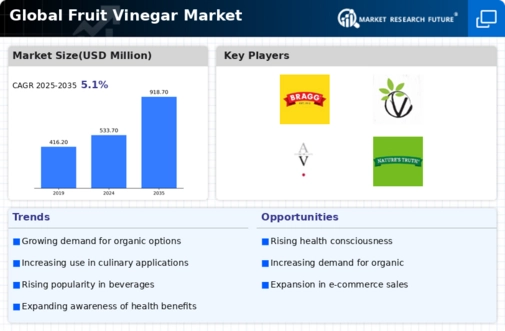Market Share
Fruit Vinegar Market Share Analysis
The Fruit Vinegar Market, a segment within the broader vinegar industry, employs various market share positioning strategies to gain a competitive edge and capture consumer preferences. One prevalent strategy involves product differentiation, where companies distinguish their fruit vinegar offerings from competitors through unique flavors, ingredients, or production methods. By introducing innovative and appealing options, companies can attract a specific target audience and carve out a niche within the market. Branding also plays a pivotal role in market share positioning. Establishing a strong brand identity helps companies build trust and recognition among consumers. This can be achieved through effective marketing campaigns, consistent messaging, and quality assurance. A well-established brand not only secures existing customers but also attracts new ones, contributing to an expanded market share. Pricing strategies are another key aspect of market positioning. Companies can choose to position their fruit vinegar products as premium, mid-range, or budget-friendly options based on factors such as ingredients, production processes, and packaging. By aligning pricing with perceived value, companies can cater to different consumer segments and potentially increase their market share. Distribution channels also impact market positioning strategies. A wide and efficient distribution network ensures that fruit vinegar products are readily available to consumers. Companies may strategically partner with supermarkets, specialty stores, or online platforms to enhance product accessibility. Accessibility and visibility contribute to increased market share as more consumers become familiar with and choose a particular brand. Innovation in packaging can be a differentiating factor in the Fruit Vinegar Market. Creative and eco-friendly packaging solutions not only attract environmentally conscious consumers but also set a brand apart from competitors. Packaging innovations can enhance the overall consumer experience and contribute to a positive brand image, ultimately influencing market share. Furthermore, companies often leverage digital marketing and social media to strengthen their market position. Engaging content, influencer collaborations, and online promotions can significantly impact consumer perceptions. A strong online presence not only helps in brand building but also allows companies to gather valuable insights into consumer preferences and market trends, enabling them to adjust their strategies accordingly. Collaborations and partnerships within the industry can also be part of market share positioning strategies. By teaming up with other businesses, such as fruit producers or retailers, companies can create synergies that enhance their overall market presence. Such collaborations can lead to shared resources, expanded distribution networks, and joint marketing efforts, ultimately contributing to increased market share. Additionally, a focus on quality and compliance with health and safety standards is crucial for market positioning. Consumer trust is built on the assurance that products meet quality benchmarks. Companies that prioritize quality control and adhere to regulatory standards not only maintain their market share but can also gain a competitive advantage by positioning themselves as reliable and responsible brands.







Leave a Comment